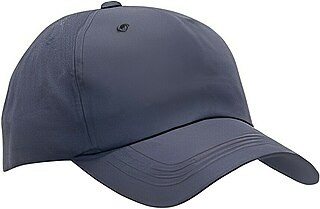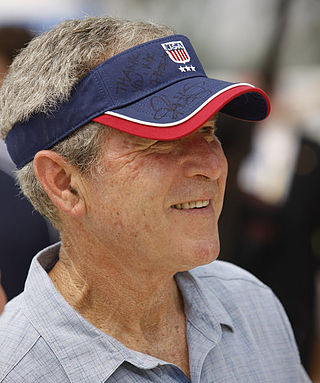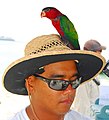
A hard hat is a type of helmet predominantly used in workplace environments such as industrial or construction sites to protect the head from injury due to falling objects, impact with other objects, debris, rain, and electric shock. Suspension bands inside the helmet spread the helmet's weight and the force of any impact over the top of the head. A suspension also provides space of approximately 30 mm between the helmet's shell and the wearer's head, so that if an object strikes the shell, the impact is less likely to be transmitted directly to the skull. Some helmet shells have a mid-line reinforcement ridge to improve impact resistance. The rock climbing helmet fulfills a very similar role in a different context and has a very similar design.

A baseball cap is a type of soft hat with a rounded crown and a stiff bill projecting in front.
A cap is a flat headgear, usually with a visor. Caps have crowns that fit very close to the head. They made their first appearance as early as 3200 BC. The origin of the word "cap" comes from the Old French word "chapeau" which means "head covering". Over time, the word has evolved and changed its meaning, but it still retains its association with headwear. Caps typically have a visor, or no brim at all. They are popular in casual and informal settings, and are seen in sports and fashion. They are typically designed for warmth, and often incorporate a visor to block sunlight from the eyes. They come in many shapes, sizes, and are of different brands. Baseball caps are one of the most common types of cap.

A hat is a head covering which is worn for various reasons, including protection against weather conditions, ceremonial reasons such as university graduation, religious reasons, safety, or as a fashion accessory. Hats which incorporate mechanical features, such as visors, spikes, flaps, braces or beer holders shade into the broader category of headgear.

A Panama hat, also known as an Ecuadorian hat, a jipijapa hat, or a toquilla straw hat, is a traditional brimmed straw hat of Ecuadorian origin. Traditionally, hats were made from the plaited leaves of the Carludovica palmata plant, known locally as the toquilla palm or jipijapa palm, although it is a palm-like plant rather than a true palm.

A boater is a semi-formal summer hat for men, which was popularised in the late 19th century and early 20th century.

A straw hat is a wide-brimmed hat woven out of straw or straw-like synthetic materials. Straw hats are a type of sun hat designed to shade the head and face from direct sunlight, but are also used in fashion as a decorative element or a uniform.

The M1 helmet is a combat helmet that was used by the U.S. military from World War II until 1985, when it was succeeded by the PASGT helmet. The M1 helmet has become an icon of the US military, with its design inspiring other militaries around the world.

The pith helmet, also known as the safari helmet, salacot, sola topee, sun helmet, topee, and topi is a lightweight cloth-covered helmet made of sholapith. The pith helmet originates from the Spanish military adaptation of the native salakot headgear of the Philippines.

The custodian helmet is a type of helmet worn predominantly by male police officers in the United Kingdom, within England and Wales, and certain other places around the world. First used by the Metropolitan Police in London in 1863, the BBC labelled the custodian helmet a "symbol of British law enforcement". They are worn by male constables and sergeants on foot patrol. A cultural icon, it has featured in films, TV series and other media involving British police.

Bunker gear is the personal protective equipment (PPE) used by firefighters. The term is derived from the fact that the trousers and boots are traditionally kept by the firefighters bunk at the fire station to be readily available for use.

Salakót is a traditional lightweight headgear from the Philippines that is commonly used during pre-colonial era up to the present day, used for protection against the sun and rain. Every ethnolinguistic group in the archipelago has their own variant, but they are all usually dome-shaped or cone-shaped and can range in size from having very wide brims to being almost helmet-like. They are made from various materials including bamboo, rattan, nito ferns, and bottle gourd. The tip of the crown commonly has a spiked or knobbed finial made of metal or wood. It is held in place by an inner headband and a chinstrap. The salakot hat also influenced the pith helmet used by European colonizers. Salakot or also spelled as salacot in Spanish and salacco in French is the direct precursor to the pith helmet widely used by European military forces in the colonial era.

The Boeotian helmet was a type of combat helmet used in Ancient Greece during the classical and Hellenistic periods, as well as in Ancient Rome; it possibly originated in the Greek region of Boeotia.

A sports visor, also called a sun visor or visor cap, is a type of crownless hat consisting simply of a visor or brim with a strap or buckle encircling the head. The top of the head is not covered and the visor protects only the face, including eyes, nose, and cheeks, from the sun.

International Hat Company, formerly named the International Harvest Hat Company, was a St. Louis, Missouri-based manufacturer of commercial hats and military helmets. The company was one of the largest hat manufacturers in the United States and, at one time, the largest manufacturer of harvest hats in the world. It is best remembered for its design and mass production of tropical shaped, pressed fiber military sun helmets for service members of the United States Army, Marines, and Navy during and after World War II. Additionally, the American owned company was a major producer of harvest hats, straw hats, fiber sun hats, enameled dress hats, baseball caps, and earmuffs throughout most of the 20th century. However, it is the International Hat military sun helmets that have become the most notable collector's items.

A Breton is a woman's hat with a round crown and a deep brim that is turned upwards all the way round, exposing the face. Sometimes the hat has a domed crown. Typically it is worn tilted to the back of the head.

A bumper brim is a millinery feature in which the hat brim is tubular in design, making it a prominent feature of the hat. In order to achieve this effect, the brim may be rolled, stiffened or padded. A bumper brim can be added to a variety of hat designs, from small to large.
George Tilles Jr. was president of the International Hat Company during World War II. Under Tilles, International Hat become one of the two dominant manufacturers of fiber pressed military pith helmets for the United States Army, Marines, and Navy. The Tilles Memorial City Park in Oran, Missouri is named in his honor.

The buntal hat is a traditional straw hat from the Philippines woven from fibers extracted from the petioles of buri palm leaves. It is traditionally worn by farmers working in the fields and was a major export of the Philippines in the first half of the 20th century. It can also be paired with semi-formal barong tagalog as well as informal attire. Its main centers of production are Baliwag, Bulacan, and (historically) Sariaya and Tayabas in Quezon Province. Buntal hats produced in Baliwag are also sometimes known as balibuntal hats, and are regarded as superior in quality to other types of buntal hats.
























